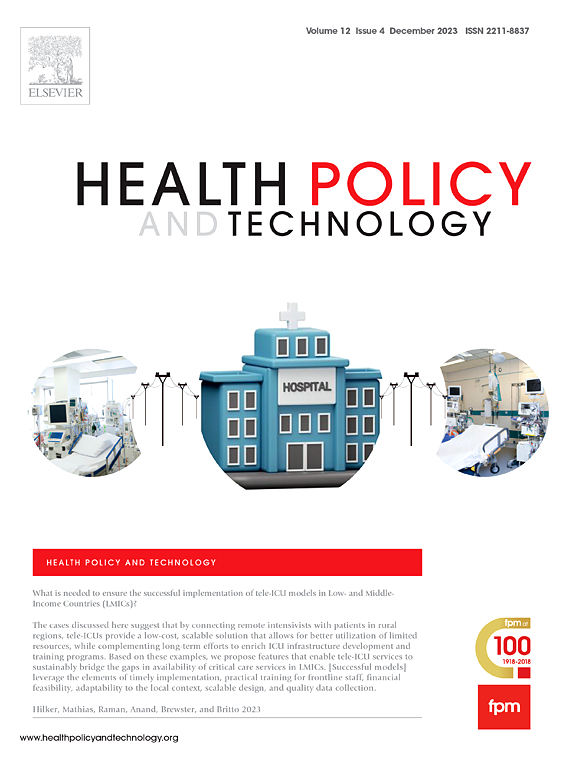Lowering inequality in access to emergency contraception: The effect of a Chilean public policy
IF 3.7
3区 医学
Q1 HEALTH POLICY & SERVICES
引用次数: 0
Abstract
Objectives
To evaluate the impact of legal changes, specifically Law 20.418, on reducing inequality in emergency contraception (EC) access in Chile between 2008 and 2013.
Methods
A longitudinal, retrospective analysis was conducted using data from the Monthly Statistical Record (REM) of the Chilean Ministry of Health. EC consultation rates were calculated for ambulatory and total consultations, including rape-related cases, across communes. Inequality was assessed using Lorenz curves and four inequality indicators: Gini index, Theil index, coefficient of variation, and 75/25 ratio.
Results
The study found a significant reduction in communal inequality in EC consultations after the implementation of Law 20.418 in 2010. Between 2008 and 2013, the Gini index for ambulatory consultations decreased by 41 %, while for total consultations, it dropped by 20 %. Other inequality indicators also showed substantial decreases, with the 75/25 ratio decreasing by 73 % for ambulatory consultations. Regional analysis revealed a consistent downward trend in inequality, with the most significant improvements occurring in areas with higher consultation rates.
Conclusions
The findings indicate that the legal reforms introduced by Law 20.418 contributed to reducing disparities in EC access across communes. Despite improvements, some residual inequalities persist, highlighting the need for further research to identify and address remaining barriers to equitable EC access in certain regions.
Lay Summary
This study evaluates the impact of Chile's Law 20.418, which mandated the provision of emergency contraception (EC) in the public health system, on reducing access inequality. Data from 2008 to 2013 show a significant decrease in inequality in EC consultations across communes. The Gini index and other inequality indicators revealed improvements, with a 41 % reduction in inequality for ambulatory consultations and a 20 % reduction for total consultations. These changes are linked to the law's implementation, which expanded EC access, particularly in rural and underserved areas. Despite the progress, some disparities remain, suggesting that while policy interventions have made access more equitable, further efforts are needed to address residual barriers. This study highlights the importance of legal frameworks in promoting health equity, particularly in reproductive healthcare.
降低获得紧急避孕方面的不平等:智利一项公共政策的影响
目的评估2008年至2013年期间智利法律变化,特别是第20.418号法律对减少紧急避孕(EC)获取不平等的影响。方法采用智利卫生部每月统计记录(REM)资料进行纵向、回顾性分析。计算了各社区的门诊和总会诊率,包括与强奸有关的案件。采用Lorenz曲线和四个不平等指标:基尼指数、Theil指数、变异系数和75/25比率来评估不平等。研究发现,2010年第20.418号法律实施后,欧共体咨询中的社区不平等现象显著减少。2008年至2013年间,门诊咨询的基尼系数下降了41%,而总咨询的基尼系数下降了20%。其他不平等指标也大幅下降,门诊咨询的75/25比率下降了73%。区域分析显示,不平等现象呈持续下降趋势,在咨询率较高的地区改善最为显著。研究结果表明,第20.418号法律引入的法律改革有助于减少各社区在获取欧共体方面的差距。尽管有所改善,但仍然存在一些不平等现象,突出表明需要进一步研究,以确定和解决某些区域公平获得欧共体的仍然存在的障碍。本研究评估了智利第20.418号法律的影响,该法律规定在公共卫生系统中提供紧急避孕(EC),以减少获取不平等。2008年至2013年的数据显示,各社区的欧共体咨询不平等现象显著减少。基尼指数和其他不平等指标显示出改善,门诊不平等减少了41%,总咨询减少了20%。这些变化与该法的实施有关,该法扩大了电子商务的使用范围,特别是在农村和服务不足的地区。尽管取得了进展,但仍然存在一些差距,这表明虽然政策干预使获得机会更加公平,但需要进一步努力解决剩余的障碍。这项研究强调了法律框架在促进健康公平方面的重要性,特别是在生殖保健方面。
本文章由计算机程序翻译,如有差异,请以英文原文为准。
求助全文
约1分钟内获得全文
求助全文
来源期刊

Health Policy and Technology
Medicine-Health Policy
CiteScore
9.20
自引率
3.30%
发文量
78
审稿时长
88 days
期刊介绍:
Health Policy and Technology (HPT), is the official journal of the Fellowship of Postgraduate Medicine (FPM), a cross-disciplinary journal, which focuses on past, present and future health policy and the role of technology in clinical and non-clinical national and international health environments.
HPT provides a further excellent way for the FPM to continue to make important national and international contributions to development of policy and practice within medicine and related disciplines. The aim of HPT is to publish relevant, timely and accessible articles and commentaries to support policy-makers, health professionals, health technology providers, patient groups and academia interested in health policy and technology.
Topics covered by HPT will include:
- Health technology, including drug discovery, diagnostics, medicines, devices, therapeutic delivery and eHealth systems
- Cross-national comparisons on health policy using evidence-based approaches
- National studies on health policy to determine the outcomes of technology-driven initiatives
- Cross-border eHealth including health tourism
- The digital divide in mobility, access and affordability of healthcare
- Health technology assessment (HTA) methods and tools for evaluating the effectiveness of clinical and non-clinical health technologies
- Health and eHealth indicators and benchmarks (measure/metrics) for understanding the adoption and diffusion of health technologies
- Health and eHealth models and frameworks to support policy-makers and other stakeholders in decision-making
- Stakeholder engagement with health technologies (clinical and patient/citizen buy-in)
- Regulation and health economics
 求助内容:
求助内容: 应助结果提醒方式:
应助结果提醒方式:


